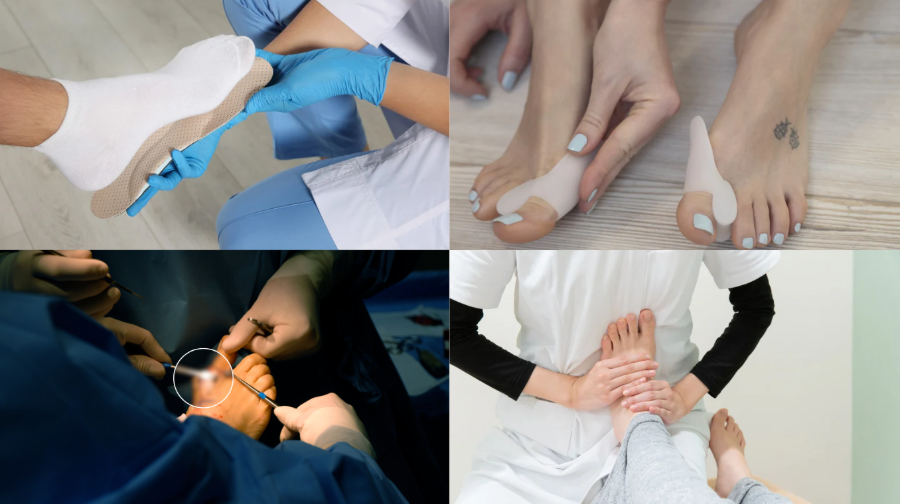When people think of bunions, the first image that comes to mind is usually the bump on the side of the big toe. While that visible bump is the most recognizable feature, the real impact of bunions goes far deeper. If you’ve ever wondered, what does a bunion feel like, the answer isn’t simple, it can range from mild aches to burning nerve pain, numbness, and even pain on the top of the foot.
Understanding these sensations is key to recognizing when bunions require professional care. Let’s explore what bunion pain feels like, how bunions can create pain in different parts of the foot, why numbness is a possible complication, and when it’s time to seek podiatric help.
What Does a Bunion Feel Like?
A bunion forms when the big toe joint shifts out of alignment, gradually causing the big toe to angle toward the smaller toes. Over time, this leads to the development of a hard, bony bump. But the bunion itself isn’t the only problem, the surrounding soft tissue, nerves, and tendons are all affected.
Patients often describe bunion sensations as:
- A dull, aching discomfort that worsens after standing or walking
- Localized tenderness along the bump
- Burning or tingling sensations if nerves are compressed
- Restricted mobility in the big toe, making it harder to walk normally
- Occasional numbness, especially when swelling is significant
So if you’re asking yourself, what does a bunion feel like, remember: it’s not just a bump, it’s an entire joint that’s under stress and often inflamed.
What Does Bunion Pain Feel Like?
Another common question is: what does bunion pain feel like? While the exact sensation depends on your activity level and footwear, the descriptions are surprisingly consistent:
- A throbbing ache after a long day on your feet
- Sharp pain when wearing narrow or tight shoes
- Stabbing discomfort when pressure is applied directly to the bunion
- Inflammatory pain that feels hot or burning
The type of pain may shift over time. In early stages, it may only flare up occasionally. As the bunion worsens, the pain often becomes chronic and can even wake people at night.
Can Bunions Cause Pain on Top of Foot?
Many people are surprised to learn that bunions don’t just hurt where the bump is located. They also ask: can bunions cause pain on top of foot?
The answer is yes. As the toe shifts, it alters how your body distributes weight. This uneven distribution can:
- Put strain on the middle and top of the foot
- Lead to soreness in the arch
- Cause secondary issues such as hammertoes or corns from altered gait
This explains why pain may appear in places you don’t immediately connect to the bunion itself.
Can Bunions Cause Numbness?
Another question is: can bunions cause numbness?
Yes, and the reason is nerve involvement. As the bunion grows, it can compress the medial dorsal cutaneous nerve or other surrounding nerves. This leads to:
- Tingling sensations around the big toe joint
- Loss of feeling in the skin near the bump
- Shooting or radiating pain into the arch or top of the foot
Numbness is an important warning sign that shouldn’t be ignored. Persistent nerve compression may result in long-term damage.
Other Symptoms to Watch For
Bunions bring more than pain and numbness. Other signs include:
- Redness and swelling around the joint
- Calluses or corns where the big toe rubs against other toes
- Difficulty fitting into shoes without irritation
- Joint stiffness, making movement increasingly difficult
If you notice any combination of these symptoms, it’s time to have your feet evaluated by a podiatrist.
When to Seek Professional Help
While some people manage mild bunions with shoe modifications, delaying professional care often allows the condition to worsen. Seek medical attention if:
- Pain disrupts your daily activities
- You notice numbness or tingling
- The bunion appears to be growing
- Shoes no longer fit properly
- You develop secondary deformities such as hammertoes
If you’re unsure whether it’s time to schedule a visit, it may help to prepare with resources like our guide: Top Questions to Ask Before Booking an In-Home Podiatry Appointment.
Treatment Options for Bunions
There is no one-size-fits-all treatment, but options include:
Non-Surgical Approaches
- Supportive footwear with a wide toe box
- Custom orthotics to redistribute pressure
- Padding or bunion shields to reduce friction
- Anti-inflammatory medications for pain relief
- Stretching and mobility exercises to maintain joint movement
Advanced Care
- Steroid injections for significant inflammation
- Physical therapy to improve function and reduce pain
- Bunion surgery (bunionectomy) in severe cases where conservative treatment fails.

What Does a Bunion Feel Like? The Takeaway
So, what does a bunion feel like? It often begins with a dull ache but can progress into sharp pain, stiffness, burning sensations, or even numbness caused by nerve compression. If you’ve wondered what does bunion pain feel like, or asked, can bunions cause pain on top of foot and can bunions cause numbness, the answer is yes. Bunions affect more than appearance, they impact your overall mobility and quality of life.
In-Home Podiatry Care for Bunions
Managing bunion pain doesn’t mean endless trips to a clinic. Allevio Care Anywhere brings podiatry services directly to your home, assisted living facility, or care center. Whether you’re struggling with bunion pain, stiffness, or numbness, our mobile podiatrists provide expert, compassionate care where you’re most comfortable.
📍Serving Houston, Utah, Idaho, and Nebraska






